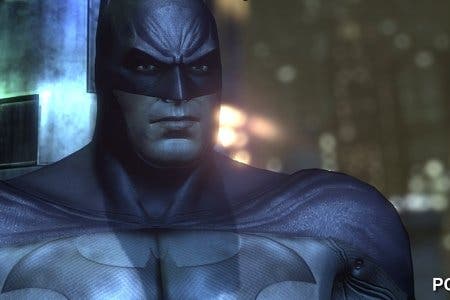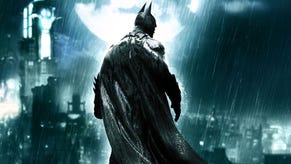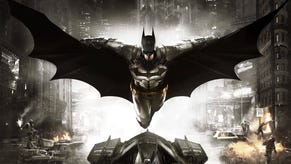PC Tech Comparison: Batman: Arkham City
Issues aside, Rocksteady's superb PC build is a huge improvement over the console versions.
PC versions of cross-platform titles are often characterised as simple ports with only the power of the hardware itself giving any advantage over their console equivalents in terms of higher frame-rates or superior resolutions. Batman: Arkham City on PC is not one of these games. It's enormously improved over the console game, even if the initially broken DirectX 11 rendering mode grabbed headlines for all the wrong reasons.
While it doesn't reach the same lofty standards set by the likes of Battlefield 3, it's clear that UK developer Rocksteady has put some effort into making the PC version a substantially better experience. While much of the artwork is shared with the Xbox 360 and PlayStation 3 builds, pretty much every corner of the game is blessed with a graphical upgrade in one way of another. Some of the differences are quite subtle, adding an extra layer of mild polish to the look of the game, while others are far more drastic, showcasing just how much more detail and clarity is possible when pairing up Rocksteady's masterpiece with a decent spec PC. It's a game that cries out to be run at resolutions well in excess of the console standard 720p.
At the forefront of this is the inclusion of a DirectX 11 rendering mode, taking advantage of advanced visual features which increase graphical complexity and provide gamers with the highest-end experience possible. The results are very impressive indeed, as we'll demonstrate shortly, but only now is it actually playable via a recently released patch - previously, the game experienced lag and stutter that ruined it in this mode.
Pre-patch, Rocksteady simply recommended that users stick to the game's DX9 setting in order to obtain smooth gameplay, and even now, users of 32-bit versions of Windows still can't access DX11 without debilitating performance levels. However, for the purposes of the initial console head-to-head, we'll concentrate on the patched game running on top tier settings on an x64 system. So here's the new game up against the PlayStation 3 version, though if you'd prefer an Arkham City Xbox 360 vs. PC comparison, we've got that covered too, plus there's the obligatery 720p triple-format comparison gallery.
As usual we've matched up the resolution with the console versions, running the game in 720p but with all graphical options fixed at their highest settings. This includes the use of 8x multi-sampling anti-aliasing, and with detail levels set to 'very high'. All DX11-specific rendering features have also been turned on, with the goal of showcasing just how much of an improvement you'll be getting when pairing up Arkham City with a decent PC. In all honesty, it's not hard to notice the difference.
How Arkham City PC Improves on Console
The most obvious boost in visual fidelity comes with the inclusion of anti-aliasing, an element missing from both the 360 and PS3 builds. The use of 8x MSAA provides ample coverage in all areas of the scene, with very little in the way of sub-pixel issues and plenty of clean lines free of obvious edge shimmering. The game looks very clean indeed, and the large amount of edge smoothing really helps to preserve subtle details far away from the camera. Dropping the amount of anti-aliasing down to a more manageable 4x MSAA also delivers a reasonably similar baseline look (though without such good sub-pixel coverage) owing to the dark nature of the game and the style of the artwork, which tends to hide the 'jaggies' quite well.
The key artwork is also hugely improved over the consoles in many areas, and the difference is striking, with the PC game offering up higher-resolution textures that are noticeably more detailed from a distance and that contain even more subtleties when viewed up close - things such as pores and indentations in the characters' skin are more pronounced, along with the textured material of their clothing (Batman himself is a triumph in this regard). Characters in general benefit the most from this upgrade, with additional surface shaders bringing the in-game models ever closer to matching their counterparts, shown in the game's in-engine cut-scenes.
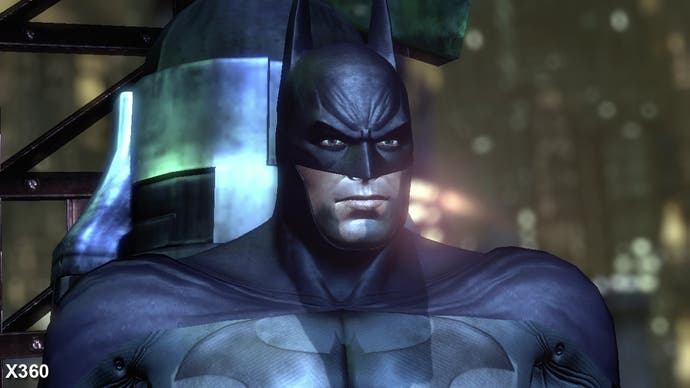


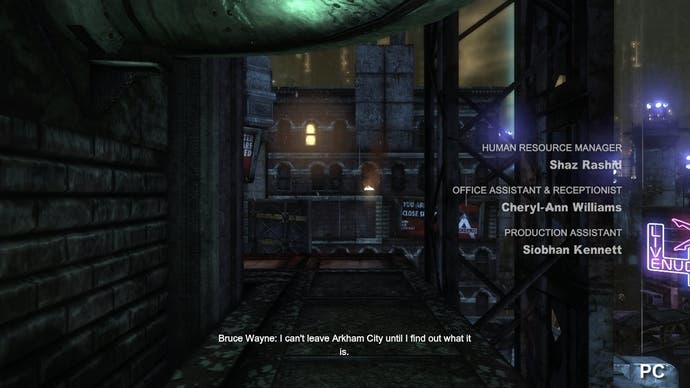
Additionally, the streaming issues present in the console versions of the game are practically gone, and parts of the environment also benefit from having more detailed texture work on PC. The harshest transitions between mip-maps are entirely absent, with higher quality art being loaded in much earlier. There are some minor instances of texture pop-in, but this is hardly visible at all when playing the game, and is part and parcel of optimising for an open-world set-up - there's no point in loading in the highest quality assets on objects very far away from the player as the finer details won't be resolved when viewing them from a distance.
Beyond the use of higher-resolution assets, another key visual upgrade when moving over to the PC version comes with the use of tessellation: a feature of the Direct X 11 renderer which adds more geometry detail to parts of the environment and characters, thus bringing more three-dimensionality to the scene. Working in combination with carefully placed displacement maps, objects which previously appeared a little flat or blocky on the consoles now feature a lot more depth and polygonal detail, with this enhancing the stylised architecture found throughout the game.
We've put together a set of shots below that give you a very good idea of what you're getting: the bricks on the wall in the top shots now feature more polygonal detail, rather than this being faked via the use of normal maps, while the rubber piping in the images below appear rounded as you would expect, compared to the more rudimentary representations seen on the consoles. All across the game we can see subtle enhancements due to the use of this technique, adding to an already polished visual experience where the art is concerned.
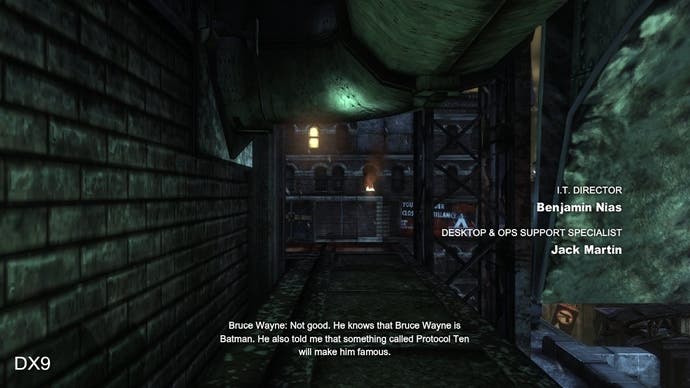


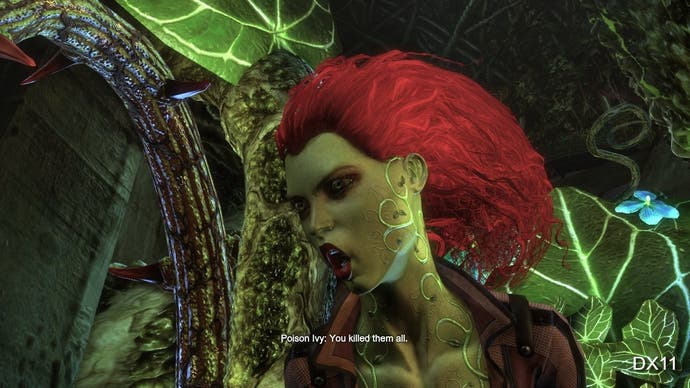
Many of these improvements scale up nicely when rendering out in higher resolutions, taking advantage of the additional pixel precision available. The already detailed artwork gains an extra level of clarity when viewed in 1080p or other console-beating resolutions, while the use of 8x MSAA (in turn with the smaller pixel structure) leads to a smooth, almost jaggie-free appearance to the game. It's fair to say that Arkham City looks absolutely stunning in these conditions, and you get the feeling that the visuals are being fully fleshed out in a way that is only possible when gaming on powerful PC hardware.
Improved Effects Work and the PhysX Factor
In other areas, improvements to the visual effects work are also evident; motion blur is rendered using a higher precision implementation, with object blur being more prominent during the cut-scenes and when performing specific, context sensitive moves. Horizon-based ambient occlusion (HBAO) adds a noticeable amount of depth to various scenes, subtly and without appearing overblown. The PC game also benefits from multi-view soft shadows (MVSS): the use of contact-hardening soft shadows for all dynamic shadows cast by both Batman and Catwoman, whereby the shadow penumbra sharpens up when either character interacts with these.
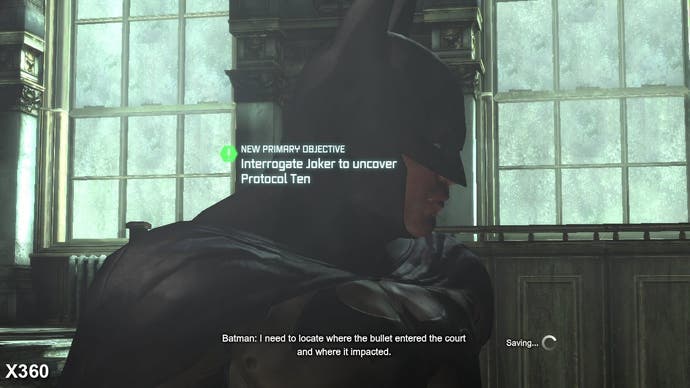



In terms of the game's lighting set-up there are additional light sources present in many scenes over the console versions, along with enhanced lighting effects in others - an extra bloom component can be found on various lights throughout the environments, with some being noticeably brighter than others. Along with this, we get the familiar HDR lighting set-up as seen on both consoles, complete with the pleasing use of Unreal Engine 3's lightshaft technology.
Beyond the more obvious eye-candy, we also have PhysX integration within the game's framework. PhysX provides users with compatible NVIDIA hardware with more realistic collision routines between smoke and particle effects, along with enhanced physics for clothing and various environmental objects; paper and debris get kicked up when fighting, wooden crates and walls splinter upon impact, and there's a general sense that yet more believability is subtly added to the game world as a result.
All in all, there's no question that the DirectX 11-powered version of Batman: Arkham City is leagues above the console SKUs, which isn't at all unexpected given Rocksteady's previously stellar work on the PC port of Arkham Asylum and the ever-increasing gap between console and computer hardware. However, considering the fine work carried out on making the PC version this superior to the 360 and PS3 releases, has the recent patch fixed the various performance issues users have been reporting?
Without the patch enabled, running Batman: Arkham City using the DirectX 11 rendering mode isn't a pretty sight where performance is concerned: essentially, the game near-constantly stutters and drops frames, often severely impacting the gameplay in a way which ruins your enjoyment. One minute things are relatively smooth, while the next everything falls apart, with regular switches between the two.
Arkham City: DX9 vs. DX11
The good news is that things have definitely improved after installation of the patch. Running the game in the highest settings still puts a strain on our i5 and GTX460 set-up, but the annoying stuttering and hitching that frequently occurred is massively reduced. Lag still kicks in during cinematic sequences and in some gameplay moments (such as the slow-motion takedowns when the last enemy is dispatched), but across a general run of play, things are far more stable. The issue is still present to some degree, but it's now an occasional annoyance than a game-breaker, and if you drop down from max DX11 settings you can still enjoy the majority of the experience without the performance issues.
So, 64-bit Windows users can finally enjoy the game in all its graphical glory (hardware specs permitting, of course). However, 32-bit Windows users aren't so lucky; Rocksteady are still working to resolve the issue, but until then they're effectively stuck with the older DX9 rendering mode as a temporary solution. This isn't a deal-breaker, but regardless, it remains shocking that the game should ship in this state in the first place. So until another patch appears that sorts out the issue for all operating systems, what's the impact of a DX9 downgrade? Is Arkham City still a console-beating game on PC?
In all honesty, the drop in visual fidelity is hardly worth shouting about considering that most of the additional upgrades found in the DirectX 11 rendering mode are still in play to some extent - albeit with simpler, lower precision versions of similar effects. While tessellation is completely absent (as such we do lose those smoother, or more three-dimensional surfaces) along with the use of MVSS for contact soft shadows, we still get the benefits of having higher-precision object motion blur above the console versions, and screen-space ambient occlusion replaces the heavier HBAO implementation found exclusively in DX11 mode. The use of AO is handled delicately, with little in the way of unsightly artifacts, and does a good job of subtly adding extra depth to the scene.
Elsewhere, the higher-resolution textures and improved surface shader effects all remain firmly in place, and scale up just as well when moving up the resolution chain. Characters feature additional geometry details and more refined use of normal mapping over the console versions, and the game still looks superb overall.
By far the main difference, though, comes in the way of performance. The game is not only smooth and playable, but also runs faster on less powerful hardware. This isn't really surprising given that the DX11 mode is still borked in this regard for 32-bit Windows users, but we do see that the additional graphical upgrades really start to shine when paired up with high frame rates. While 8x MSAA in combination with PhysX set on normal proved a little too much for our Core i5 and GTX 460 combo to manage (we got between 50 and 20 frames per second depending on draw distance and scene complexity), dropping AA down to 4x and turning off PhysX altogether helped to stabilise things a little without having to disengage v-sync.
However, owners of a top end Core i7 and GTX580 set-up should be able to enjoy a far more consistent 60FPS experience without any concerns at 1080p, providing a definitively superior experience over the 360 and PS3 builds, while Rocksteady themselves recommend a GTX570 class GPU as a solid starting point, with a second GPU attached to the system if you want to enjoy the PhysX effects at max.



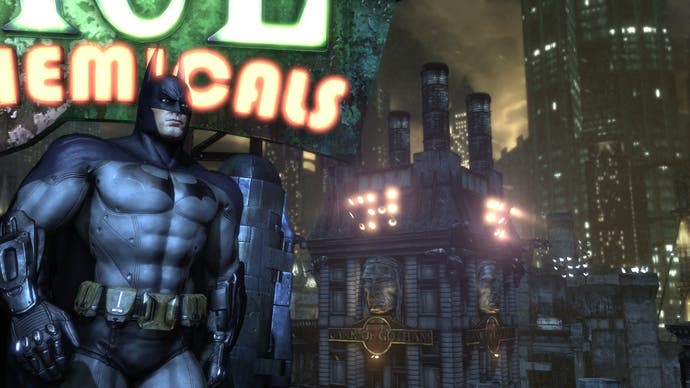
In all fairness, some of the enhanced DirectX 11 feature set simply adds extra subtleties to the game's graphical make-up, rather than providing another gigantic leap over and above the Xbox 360 and PlayStation 3 releases. In that respect, the boost in visual quality gained from the use of higher resolution artwork, more detailed characters, and improved lighting - all contained within the lower-end DirectX 9 framework - is easily enough to make Arkham City on the PC by far the best version to get. The leap over the consoles is night and day, and as a result of the superior performance the game is more fun to play.
There's also full support for NVIDIA's stereoscopic 3D Vision technology - while this does present further performance implications, the 3D effect is remarkable, especially on the newer 3D Vision 2 set-ups. Games with platform-style elements like Arkham City definitely benefit from increased depth perception, but it's the quality of the modelling and the materials that generally look fantastic when viewed in 3D, and the open world elements in particular present some spectacular views that are greatly enhanced with 3D Vision. Be prepared to fiddle with settings to get a consistent level of performance though: we found that 1080p 3D even with a GTX580/i7 combo required dialling down some settings and opting for the DX9 renderer.
Overall, while the game-breaking bugs in the DX11 mode can only be viewed as a massive own-goal (thankfully, mostly resolved now when running a 64-bit OS), the PC version of Arkham City is still absolutely worth your time and your money, clearly showcasing the benefits of the platform against the ageing console hardware more than most multi-platform titles, and presenting a wealth of lovely new features - especially so for owners of more powerful NVIDIA graphics cards.
And if you didn't already know, Arkham City is also a superb sequel that manages to out-quaff the original in almost every way, delivering the most impressive Batman game we've seen so far - and if you've not experienced it yet, the PC version is the one to get.
